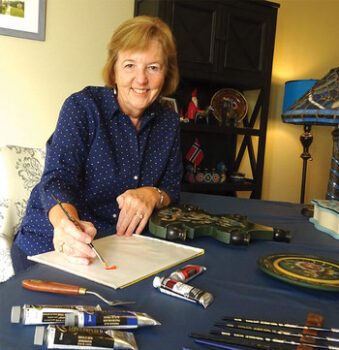
Connie Kotke begins to prepare paint for a piece of rosemaling. (Photo by LaVerne Kyriss)
LaVerne Kyriss
Connie Kotke first learned about rosemaling when she was a teen attending Norwegian camp. This summer experience immersed her in all things Norwegian, from language and crafts to food and culture. She explained that rosemaling is a decorative folk art that originated in Norway in the late 1600s and reached its height in the mid-1800s. “Traveling artists traversed their home valleys, painting churches, homes, and furnishings for pay or room and board. Common design elements are C and S strokes, scrolls, flowing lines, flowers, dots, and other enhancements,” she added. The style was inspired by the Rococo artwork found across Renaissance Europe.
Kotke reflected that Norway has long, cold winters, especially the further north you live. “Rosemaling was a way to brighten up homes that were dark from Oct. 1 to May 1 and a way to replicate nature that was covered in snow,” she explained. Rosemaling has about 20 different styles that developed in the different geographic areas of Norway. “Remember, those valleys were often isolated, especially during the winter months,” she said. “This resulted in distinctly different styles.”
Kotke put aside rosemaling as she grew up, began a career, and raised a family. Then, about eight years ago, her interest was rekindled when she took a workshop. “There’s a vibrant community,” she said. “Rosemaling is perhaps even more popular in the U.S. than in Norway. There are online and in-person classes, Facebook groups, and statewide and regional organizations. I was able to take a number of classes at Vesterheim in Decorah, Iowa. Through these, I’ve learned four styles of rosemaling.”
Kotke said that a typical, small piece takes her about 20 hours to complete. She begins by developing a design and sketching it to fit the piece on which she will work. Next, she uses tracing paper over the design to draw the main outlines and then transfer or carbon paper to copy that outline to the surface on which she’s working. While rosemaling is traditionally painted on wood, it can be applied to a number of surfaces, including glass and leather. She works in oils exclusively. “I like having the time to go back and re-blend. I like the feel of oils. Acrylic paint just dries too fast to get the smooth blends. I use just enough walnut alkyd to work the paint.”
Kotke noted that painting begins with the midrange colors on the main design element. These are often the flower petals or leaves. “Next you add the shadow with a darker shade. You have to determine where the light is coming from. You begin to layer in the colors, smoothly blending so you don’t see the edges. Next, you add the lighter shades, again blending and reblending. Once your main design elements are completed, you go back in and add the fine detail work with a fine liner brush. This includes outlines, tendrils, and teardrops. Finally, you add a border,” she summed up.
Kotke will be teaching an introductory rosemaling class through the SaddleBrooke Fine Arts Guild in the spring. “I look forward to introducing these techniques to people in our community. We’ll complete a simple project that will give you an introduction to some of the basic techniques and design elements.”
Visit the guild’s website at saddlebrookefinearts.org for details on the upcoming rosemaling and other classes.
